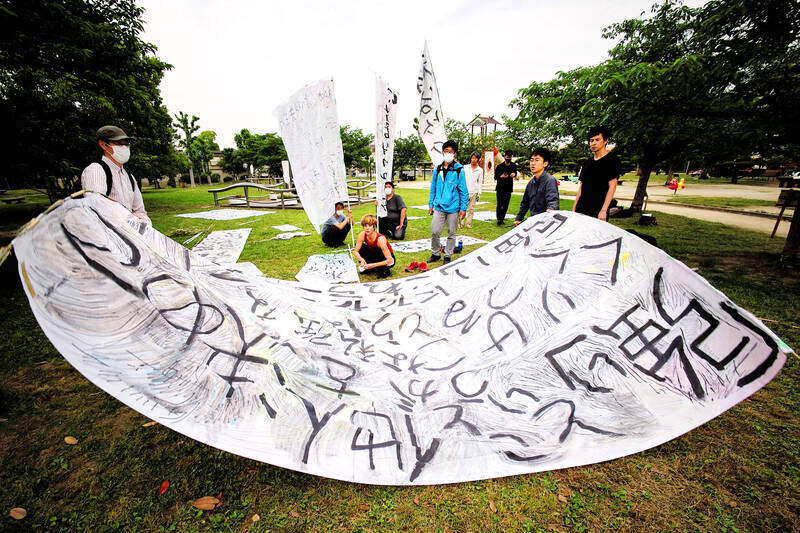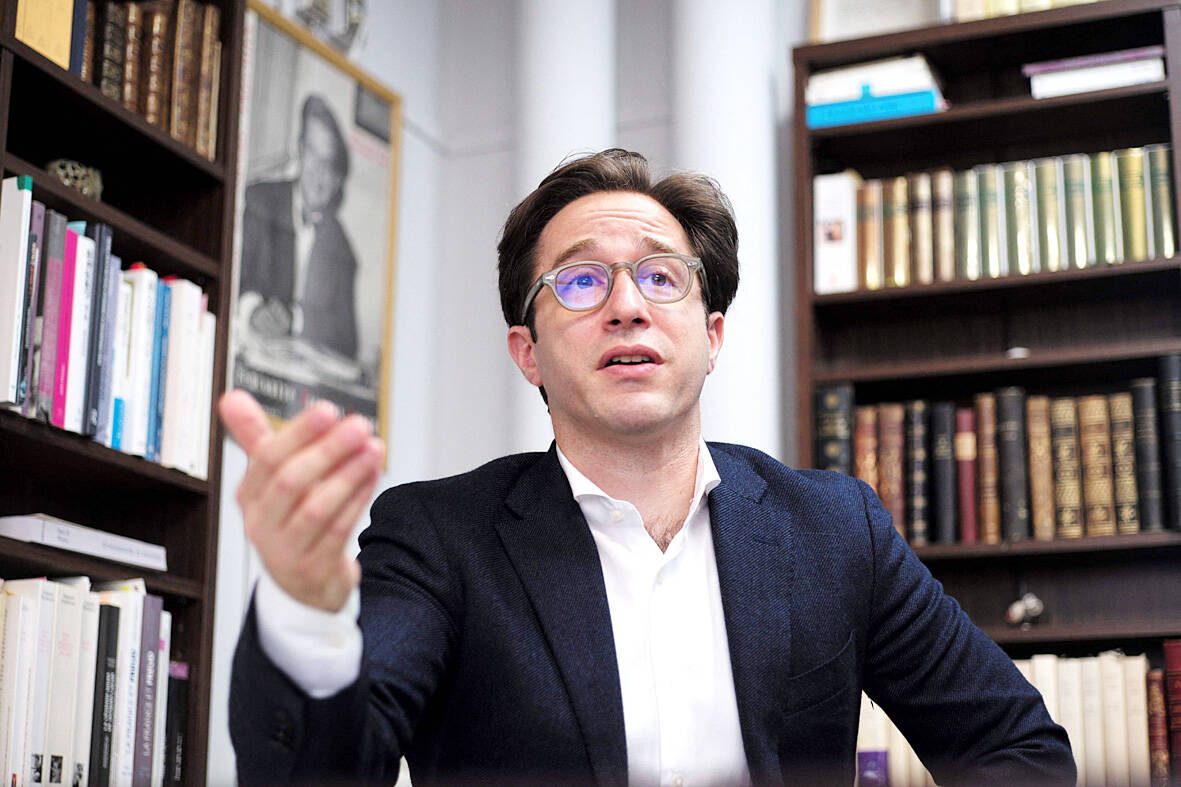Disillusioned by work and tired of life, Seiji Yoshida withdrew from the world for seven years, but now he’s taking part in a play about the experiences of Japan’s hikikomori, or social recluses.
The 42-year-old spent most of his thirties shut inside his home.
“I was going through the motions of life, but lying to myself. Apart from work, I had nothing. I’d just had enough,” he said at a workshop for the international production.

Photo: AFP
Yoshida was among more than a million Japanese aged 15 to 64 who lead highly reclusive lives, withdrawing from all social contact for at least six months, according to a 2020 government estimate.
Through an experimental theater project, two French artists are hoping to offer hikikomori — or “shut-ins” as they are often referred to in English — a chance to express themselves and regain self-confidence.
Their play Hiku — to be shown next year in France, Belgium and elsewhere in Europe — aims to give hikikomori a platform for self-expression, while respecting their desire for isolation.

Photo: AFP
It features robots controlled by participants at home in Japan and voice recordings of conversations held through bedroom doors.
It also includes footage from small but noisy street demonstrations staged by hikikomori who are taking steps towards leaving their confinement — but who feel oppressed by Japan’s demanding work culture.
“We don’t want to be forced to work! Stop oppressing us!” participants chanted at one demonstration filmed in the city of Takatsuki in western Japan.

Photo: AFP
Yoshida, who took part in the protest, said he was “very proud” to be part of the theater production.
‘ROBOT AVATARS’
The producers are working in Takatsuki with a local organization, New Start Kansai, which provides support and company for hikikomori to help them gradually readjust to life in society.
“It’s a social problem... but society has made (hikikomori) believe that the problem comes from them,” said Atsutoshi Takahashi, a mediator at the association.
Nicolas Tajan, a psychoanalyst and associate professor at Kyoto University, said hikikomori often faced difficulties in childhood.
In Japan, “childhood and adolescent psychological difficulties are not addressed and not treated,” he said. “That means in adulthood it can crystallize into a type of social withdrawal.”
As adults, they face additional problems as they “are looked down on because they don’t work,” he added, noting that “work is really a very important part of Japanese identity.”
Around a dozen recovering hikikomori are taking part in the project.
Some will control robots from 10,000km away during the play, painting messages on the floor and talking to spectators through microphones.
The robots are “a sort of avatar” to explore “being present and absent at the same time, a recurring theme for hikikomori,” said co-director Eric Minh Cuong Castaing, a visual artist and dancer.
He hopes the production will help audiences reflect on their own lives, arguing that while hikikomori are sometimes regarded as weak, their actions represent a kind of resistance to being “a soldier in a suit and tie.”
‘PREJUDICES’
When the French artists began researching the project in Japan, they took time to build connections with the isolated people introduced to them by New Start Kansai.
“It was a big challenge for some of them to let us into their homes and speak to us,” said co-director Anne-Sophie Turion, who will perform in the play as a narrator.
She said being strangers from another country may have made things easier, “because the usual prejudices weren’t there.”
“We found people who we felt closer to than we ever could have imagined.”
Recovery can be difficult for hikikomori, who fear once they have withdrawn from society, they won’t be allowed back in, psychoanalyst Tajan said.
“This reinforces their avoidant behavior.”
But art can help reclusive individuals “reconnect with creativity” and envisage “another world” beyond psychiatric treatment or re-entering employment, he said.

The Nuremberg trials have inspired filmmakers before, from Stanley Kramer’s 1961 drama to the 2000 television miniseries with Alec Baldwin and Brian Cox. But for the latest take, Nuremberg, writer-director James Vanderbilt focuses on a lesser-known figure: The US Army psychiatrist Douglas Kelley, who after the war was assigned to supervise and evaluate captured Nazi leaders to ensure they were fit for trial (and also keep them alive). But his is a name that had been largely forgotten: He wasn’t even a character in the miniseries. Kelley, portrayed in the film by Rami Malek, was an ambitious sort who saw in

Last week gave us the droll little comedy of People’s Republic of China’s (PRC) consul general in Osaka posting a threat on X in response to Japanese Prime Minister Sanae Takaichi saying to the Diet that a Chinese attack on Taiwan may be an “existential threat” to Japan. That would allow Japanese Self Defence Forces to respond militarily. The PRC representative then said that if a “filthy neck sticks itself in uninvited, we will cut it off without a moment’s hesitation. Are you prepared for that?” This was widely, and probably deliberately, construed as a threat to behead Takaichi, though it

Among the Nazis who were prosecuted during the Nuremberg trials in 1945 and 1946 was Hitler’s second-in-command, Hermann Goring. Less widely known, though, is the involvement of the US psychiatrist Douglas Kelley, who spent more than 80 hours interviewing and assessing Goring and 21 other Nazi officials prior to the trials. As described in Jack El-Hai’s 2013 book The Nazi and the Psychiatrist, Kelley was charmed by Goring but also haunted by his own conclusion that the Nazis’ atrocities were not specific to that time and place or to those people: they could in fact happen anywhere. He was ultimately

Nov. 17 to Nov. 23 When Kanori Ino surveyed Taipei’s Indigenous settlements in 1896, he found a culture that was fading. Although there was still a “clear line of distinction” between the Ketagalan people and the neighboring Han settlers that had been arriving over the previous 200 years, the former had largely adopted the customs and language of the latter. “Fortunately, some elders still remember their past customs and language. But if we do not hurry and record them now, future researchers will have nothing left but to weep amid the ruins of Indigenous settlements,” he wrote in the Journal of